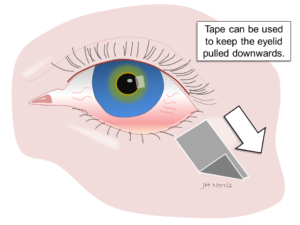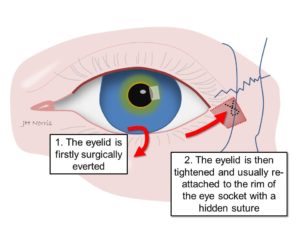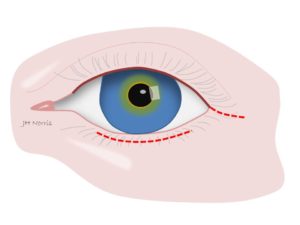An entropion is an in-turning of the eyelashes. There are many causes for this although the most common is laxity of the eyelid often associated with age. Other causes usually involve scarring to the eyelids
An entropion will cause the eye lashes to rub the eye which often causes irritation and can affect your vision (tap to enlarge).
The mainstay of treatment is surgery which is aimed at correcting the position of the eyelid. Whilst you are on the waiting list to have the surgery performed we advise that you tape your eyelid to the cheek (tap images to enlarge).
You can also use lubricants in the eye. These measures will help reduce the eye lashes irritating the eye.
We normally perform your surgery under local anaesthetic which is given in the operating room. Occasionally we can give sedation at the same time if you are uncomfortable about having a local anaesthetic on its own.
The surgery itself involves everting the eyelid and tightening it to prevent the entropion from returning. Tap to enlarge image.
The scar line runs underneath the eyelash line and there is a second small incision to the skin at the outer edge of your lower eyelid. These incisions are designed to be hidden within your natural skin creases. Tap to enlarge image.
The sutures we use are dissolvable but sometimes they still need to be removed in clinic.
The surgery normally takes about 25 minutes per eyelid but can sometimes take longer.
Prior to surgery the team will see you in clinic and discuss the treatment options with you at this stage. If you are happy to go ahead with surgery we will normally consent you for the procedure and you will need to sign a form.
You may then need to be pre-assessed for the surgery whereby a nurse will ask you some questions about your general health should the doctor feel that this is necessary. On occasion we may take some blood tests and may ask you change your medications prior to surgery. The pre-assessment may take place on the day of your clinic visit, on a subsequent day or even over the telephone.
The risks of surgery include postoperative bleeding, scarring to the eyelids and infection. We advise that you use an antibiotic ointment after the surgery (see below) to help reduce the risk of infection. Occasionally we may under or over correct the position of the eyelid. During the surgery we put some stitches near the bone on the outside of the eye socket, rarely patients can complain of tenderness in the area of this stitch. Most of these complications can be corrected if needs be with a second operation.
The most serious risk of any eyelid surgery performed is damage to your eyesight. Fortunately this risk is extremely rare.
On the day of surgery you will be told a time and place to come to the hospital. You will be met by the nursing team and one of the surgical team will also see you.
If you are booked for day case surgery you will need to make sure that someone can be with you on the evening of surgery. If you are coming to stay the night you will need to bring some overnight clothes and toiletries for the duration of your stay. We advise that you also bring in your medications with you when you come into hospital.
Sometimes you may have to wait for a few hours before your surgery is performed and this depends on your position on the operating list.
This type of surgery is usually performed as a day case operation and we normally allow you to go home about 30 minutes after the surgery is finished.
The eyelids will be bruised after surgery and you may have some bloodstained tears which is quite normal initially.
The eyelid will often look quite tight for the first couple of weeks. This settles down as the eyelid relaxes into its normal position much like a leather belt stretching after you have worn it for a few days.
Normally we ask that you keep the wounds around your eye clean after surgery. You can clean the wound by allowing boiled water to cool and gently dabbing the wounds with a cotton bud.
We will give you some antibiotic ointment (usually Chloramphenicol) to apply to the wounds and to the eyes after the surgery to help protect against infection and to help lubricate the eyes for two weeks.
We normally advise that you apply ice compresses to the eyelids after surgery for three times a day for 5 minutes each time. This is to help reduce the bruising.
We normally see you 1-2 weeks after surgery to remove any sutures.
You should avoid any strenuous activity including lifting heavy objects for a least two weeks and avoid swimming for three weeks after surgery.
Usually patients are quite anxious after having surgery near their eyes and most problems do settle with time. Problems that require immediate attention are the onset of new double vision, loss of vision and pain that cannot be controlled with standard over-the-counter painkillers. Please refer to the emergency contact page (in contacts) if you need advice.
Author: Mr Jonathan Norris FRCOphth






